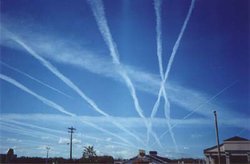Contrail
|
|
Missing image Contrail.bristol.four-engined.arp.jpg The contrail of a four-engined jet over Bristol, England |
Missing image Contrails_over_Nova_Scotia.jpg A satellite photo of Nova Scotia showing numerous contrails of jets travelling between the Eastern Seaboard and Europe. |
Contrails are condensation trails (sometimes vapour trails): artificial clouds made by the exhaust of jet aircraft or wingtip vortices which precipitate a stream of tiny ice crystals in moist, frigid upper air. They are the cloud-like trails of water vapour that can be seen in the wake of airplanes, either from their exhaust or sometimes from their wing tips.
| Contents |
Contrail creation
Contrails are created in one of two ways:
1. Firstly, the airplane's exhaust increases the amount of moisture in the air, which can push the water content of the air past saturation point (see saturation or dew point). This causes condensation to occur, and the contrail to form.
The atmosphere contains water (which is why rain occurs) and although most aero-engines are thought of as running on a fuel such as petrol/gasoline (piston engines) or paraffin/kerosene (jet engines) they actually use a mixture of fuel and air, the air being taken from the atmosphere. This air contains moisture in the form of water-vapour, which passes through the engine and is heated in the cylinders/combustion-chambers and emerges as superheated steam in the exhaust. For every gallon of fuel burnt, approximately one gallon of water (steam) is produced, depending on the fuel/air ratio. At high altitudes this steam emerges from the exhaust into a freezing environment, (as altitude increases, the atmospheric temperature drops) which lowers the temperature of the steam until each individual droplet freezes into tiny ice crystal. These millions of tiny ice crystals form the contrails. The time the steam/water droplets take to freeze accounts for the contrail forming some way behind the aircraft's engines - see The contrail of a four-engined jet over Bristol, England above.
2. The wings of an airplane causes a drop in air pressure in the vicinity of the wing (this is partly what allows a plane to fly). This drop in air pressure brings with it a drop in temperature, which can cause water to condense out of the air and form a contrail. Exhaust contrails tend to be more stable and long-lasting than wing-tip contrails, which are often disrupted by the aircraft's wake.
NASA experiment
In 1998, NASA scientists found that by circling a jet off the Pacific coast of the United States they were able to create contrails that eventually coalesced into a cirrus cloud covering 1,400 mile² (3,600 km²). Satellite photographs have confirmed that on one occasion jet contrails produced by commercial aircraft over New England formed a cloud covering 13,000 mile² (34,000 km²).
Sept. 11th, 2001 Climate Impact Experiment
It had been hypothesized that in regions such as the United States with heavy air traffic, contrails affected the weather, reducing solar heating during the day and radiation of heat during the night by increasing the albedo. The suspension of air travel for 3 days in the United States after September 11, 2001 provided an opportunity to test this hypothesis. Measurements did in fact show that without contrails the local diurnal temperature range (difference of day and night temperatures) was about 1 degree Celsius higher than immediately before. This has been hypothesised as a significant factor in global dimming, the process of reducing the light reaching the earth's surface, that has the effect of cooling for surface and thereby countering global warming.
See also
- Chemtrail theory — for a conspiracy theory alleging that some contrail-like clouds are not true contrails but are the result of high-altitude chemical spraying.
- list of environment topics

